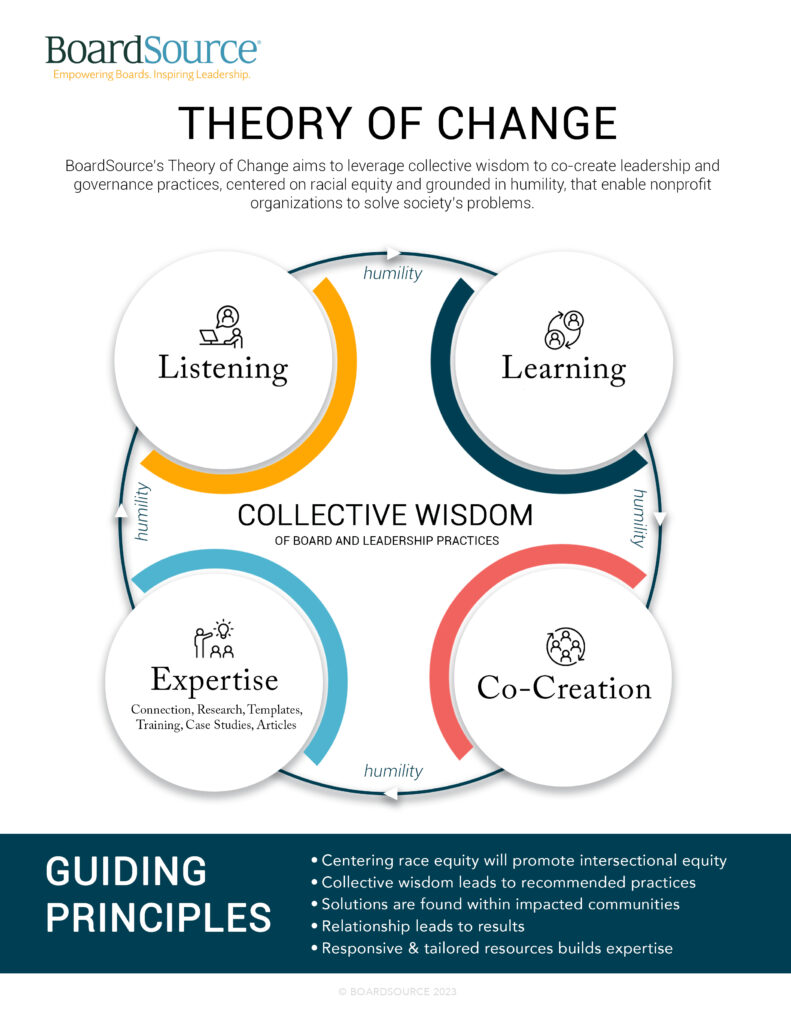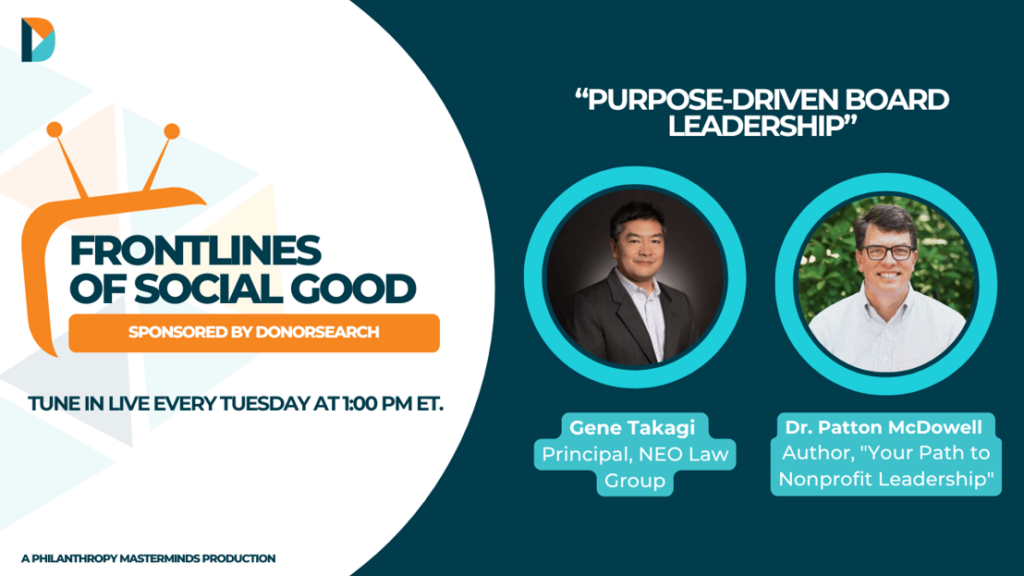
I had the pleasure of speaking with host Jay Frost on the Frontlines of Social Good podcast last week. We talked about a model of nonprofit governance known as purpose-driven board leadership (PDBL), with special attention on how diversity, equity, and inclusion (DEI) fits into the model. Here are some notes I took in preparing for the interview and additional resources.
Background
- PDBL is a governance model developed by BoardSource grounded in fundamental governance provisions including mission-based governance, values-based governance, stakeholder governance, and adaptive governance, but reimagined through a purpose-first, equity-conscious, stakeholder-centered lens.
- Some nonprofit leaders like Phil Buchanan of the Center for Effective Philanthropy consider it a game-changer. See Re-Purposing Foundation Board.
- BoardSource’s Theory of Change recognizes that PDBL will further evolve as BoardSource listens to, learns from, and cocreates with, the community and embeds this process with humility.

4 Principles of PDBL
- Purpose Over Organization – mission/vision/values > self-sustainability; this is what allows for dissolutions and mergers even if an organization is economically viable
- Respect for Ecosystem – acknowledgment that (a) an organization’s actions can positively or negatively impact its surrounding ecosystem (conversely, the ecosystem and its players’ actions can impact the organization); and (b) a commitment to making choices that provide a net benefit, not just to the organization, but to the entire ecosystem (including the intended charitable class served by the organization)
- Equity Mindset – a commitment to advancing equitable outcomes, requiring an interrogation and avoidance of the ways in which the organization’s strategies and work may reinforce systemic inequities (from a legal perspective, this principle may only be applicable if equity and fairness are among the organization’s values); an equity mindset can impact what neighborhoods an organization seeks to serve, how it targets its recruitment and fundraising, and how it develops a budget in consideration of intergenerational equity (e.g., deciding whether to spend now or later wisely, knowing that in some cases, spending money now will better help future generations of beneficiaries than spending it later when it may be too late to efficiently address a problem (e.g., climate change))
- Authorized Voice & Power – in relation to the other principles, the issue of whether the organization has sufficient representation and is engaged in sufficient dialogue with its communities to justify its equitable representation of the communities, including those impacted by the organization’s work
Equity Mindset and DEI: Current Challenges
- These are challenging times for many organizations to publicly market and advocate DEI principles and activities, but DEI principles, as commonly understood, are lawful, and the vast majority of nonprofit activities guided by such principles are lawful – see, e.g., What’s Up With DEI?
- A a coalition of 16 attorneys general, issued guidance to help businesses, nonprofits, and other organizations understand the viability and importance of diversity, equity, inclusion and accessibility policies and practices in creating and maintaining legally compliant and thriving workplaces
- The definition of charitable within the meaning of 501(c)(3) includes:
- These charitable purposes may be lawfully advanced with service delivery focused on members of one or more specific marginalized race groups
- However, there are a couple areas in which organizations that think they are advancing DEI principles may be engaged in unlawful or potentially unlawful actions:
- Employment actions (e.g., hiring, firing, promoting, demoting) based on race
- Making and enforcing of contracts based on race – see, e.g., Anti-Discrimination Laws – Section 1981; Fearless Fund Case – 11th Circuit Opinion
- In addition, there is the 2023 Supreme Court opinion that made the consideration of race in admissions decisions of colleges and universities unlawful – see, e.g., Supreme Court Affirmative Action Decision
- Organizations may also need to think about the discretion federal agencies and private funders (e.g., foundations) have in determining what organizations they want to fund and whether openly having lawful DEI-focused programs, activities, or principles may adversely impact their ability to receive such funding
- On the other hand, organizations must also consider the impact on their purpose, ecosystem, equity mindset, and authorized voice and power if they scrub some or all of their DEI values, communications, and activities, particularly over time (what damage might an organization do to its purpose and ecosystem, not to mention its continued relevance, if it is viewed as among those that capitulated to threats and rhetoric?)
- There are options for mitigating risk without giving up on DEI principles and activities (e.g., reframing the communications in a way that respectfully maintains the organization’s focus on fairness and justice; avoiding contractual language in grant awards, scholarships, and programs designed to advance marginalized race groups and their representation in decision-making bodies; collaborating with other organizations and joining in on lawful efforts to oppose unjust and unfair expressions of power)
- Of course, there is not a single course of action for all organizations, but PDBL may be a strong way for Boards and organizational leaders to learn, think, and adapt their way through chaotic times full of rhetoric, often intentional misstatements of law, fear, exhaustion, and burnout

Resources
Purpose-Driven Board Leadership (BoardSource)
Purpose-Driven Board Leadership: A Conversation Starter for Boards (BoardSource)
The Four Principles of Purpose-Driven Board Leadership (Anne Wallestad, SSIR)
You must be logged in to post a comment.